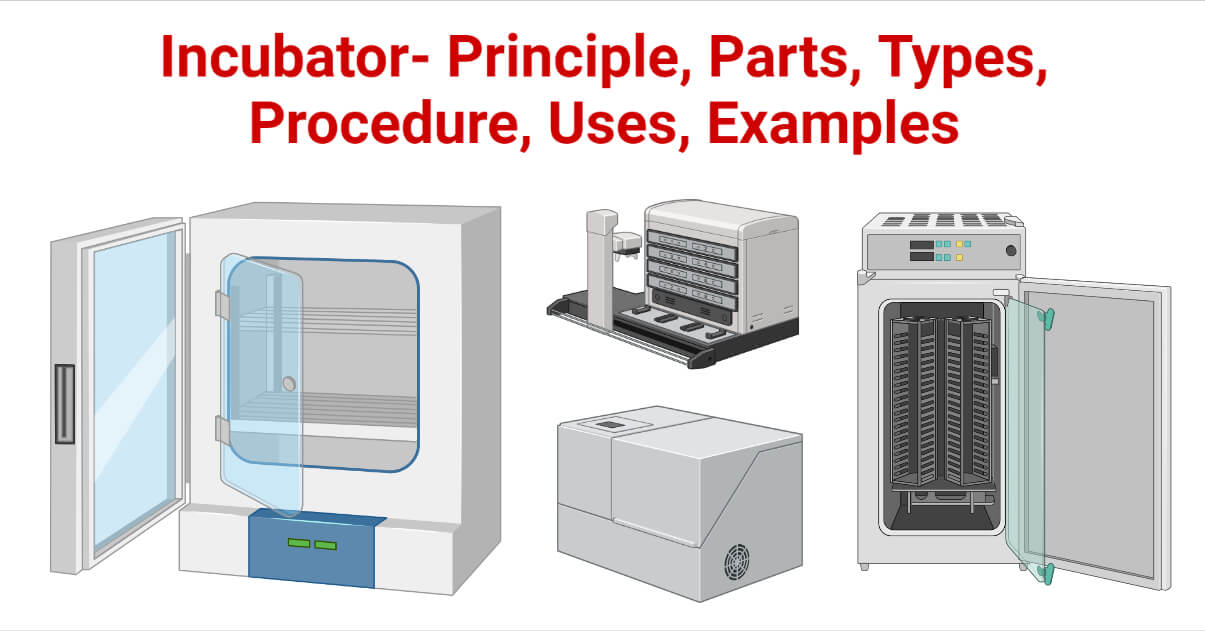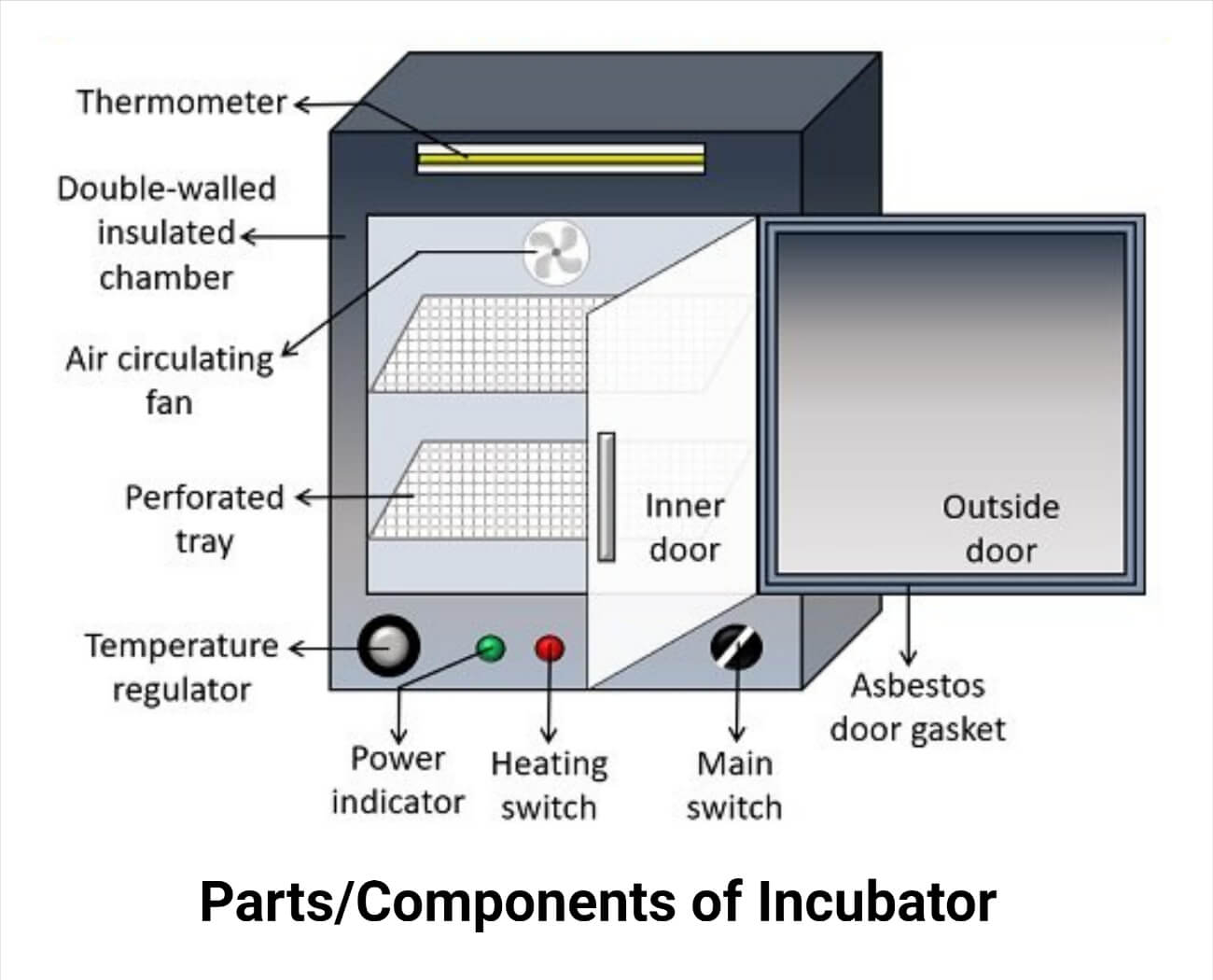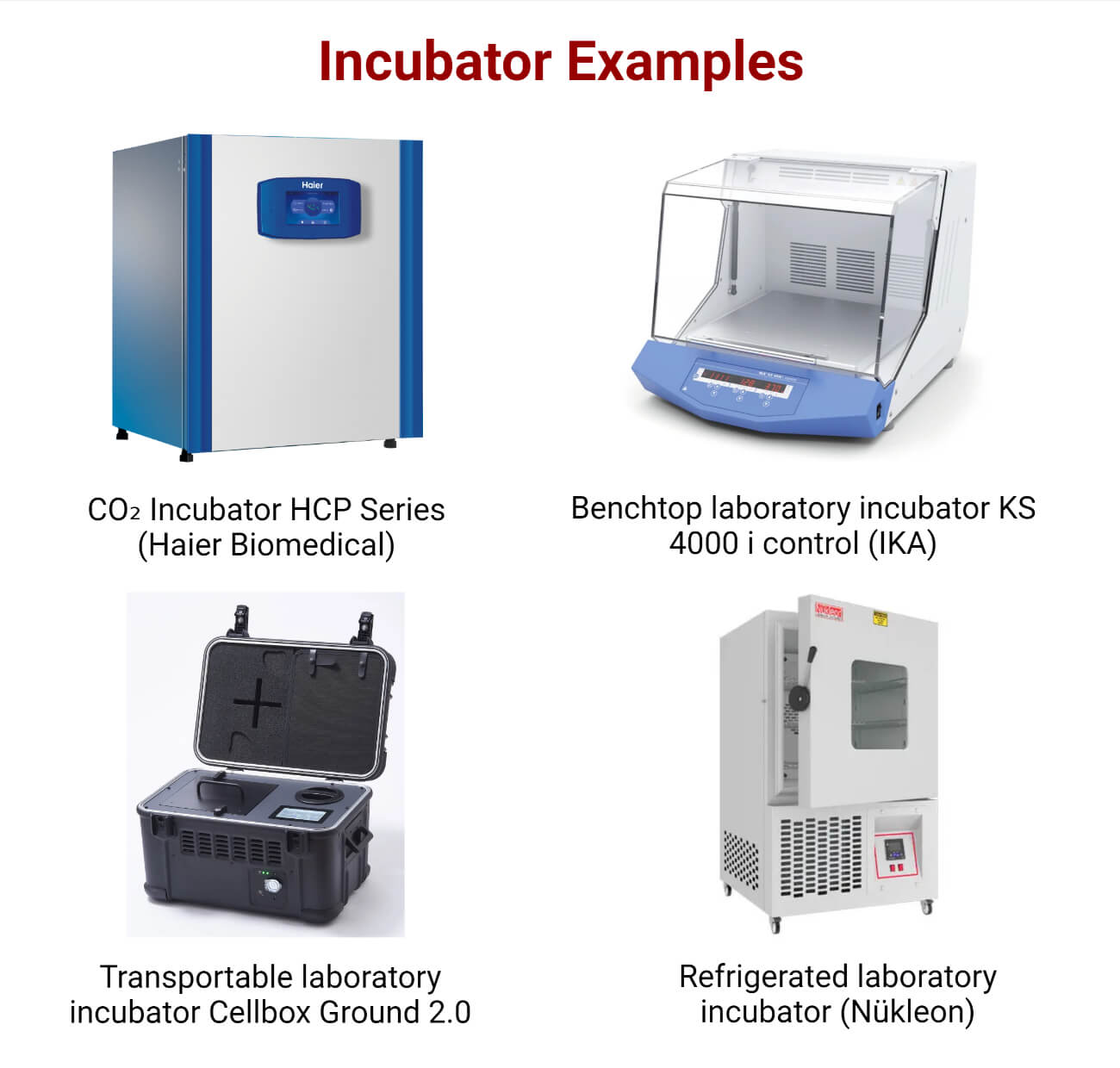An incubator is a heated, insulated container used in laboratories to cultivate and preserve cell or microbiological cultures.
Data loggers with sensors are used to monitor temperature during calibration. Incubators can be used to culture both single- and multicellular organisms.

Its main role is to control environmental factors like temperature, humidity, and CO2 to create a safe and reliable environment free of contaminants for work with cell and tissue cultures. Microorganisms are grown in incubators in various fields, such as pharmaceuticals, agriculture, environmental, food, and industrial microbiology, public health, fundamental research, and education. Bacterial cultures, cell and tissue culture, biochemical and hematological research, pharmaceutical operations, and food analysis require lab incubators for growth and preservation.
Interesting Science Videos
Principle of Incubator
Incubator operates under the thermoelectricity principle. The thermostat in the incubator produces a thermal gradient to keep the temperature constant. Any conductor will produce voltage when it is exposed to a heat gradient, which is known as the thermoelectric effect. The incubator is heated to a predefined temperature (37°C) as power is applied to the circuit. The compatibility and efficient performance of the temperature sensor, temperature controller, and temperature contactor are key elements in maintaining this temperature. When the switch is turned off, current enters the system, energizing the contactor that powers the bulbs, which operate as heating elements for the system. Hot air is distributed throughout the entire system thanks to the fan. When the system’s temperature reaches the desired level (37 °C), the digital temperature controller sends an electrical signal to the contactor, which de-energizes and momentarily turns off the heaters. Additionally, the contactor will be recharged and turn on the system when the temperature falls below the desired level.
Parts/Components of Incubator
The components of the incubator are described below:
- Cabinet
- The basic body of the incubator is the cabinet, composed of a double-walled cubical container with a volume range of 20 to 800L.
- The outer wall is constructed out of stainless steel sheets, and the inside wall is constructed out of aluminum. The inside wall of the incubator has inward extensions that hold up the shelves.
- The space between the two walls of the incubator is filled with glass wool to act as insulation. Insulation ensures the smooth operation of the instrument by preventing heat loss and reducing electricity consumption.
- Door
- The door that seals the insulated cabinet is a standard feature on all incubators. The door itself is insulated.
- Additionally, it incorporates a glass pane that permits visual inspection of the incubator’s interior while incubating without disturbing the environment.
- There is a handle on the door’s exterior to help with door maneuvering.

- Control Panel
- The outer wall of the incubator is covered with a control panel that has all the switches and indicators needed to control the incubator’s parameters.
- A switch on the control panel also operates the device’s thermostat.
- Asbestos Door Gasket
- The asbestos door gasket forms a nearly airtight barrier between the door and the cabinet. This seal guard against damage to the cabinet.
- It keeps outside air from entering the cabinet, creating an enclosed, hot atmosphere that is not influenced by environmental variables.
- Perforated shelves
- The internal wall has some perforated shelves connected, and the plates carrying the cultural media are placed there. Some incubators have shelves that can be removed so they may be properly cleaned.
- Hot air can freely circulate throughout the incubator thanks to perforations on the shelves.
- Thermostat
- A thermostat regulates the temperature of the incubator.
- The incubator is maintained at the set temperature once it has been reached by the thermostat until the temperature is changed once more.
- L-shaped Thermometer
- The outer wall of the incubator is where the thermometer is mounted.
- One end of the gradation-equipped thermometer is left outside the incubator to make it simple to read the temperature.
- HEPA filters
- Some modern incubators come with HEPA filters to lessen the chance of contamination from airflow.
- A closed-loop system created by an air pump with filters lowers pollution in the air circulating inside the incubator.
- Humidity and gas controllers
- A water reservoir is located beneath the chamber of the CO2 incubators.
- The water is evaporated in order to maintain the relative humidity inside the chamber.
- Similarly to that, gas chambers are incorporated into these incubators to give the proper CO2 concentration within.
Types of incubators
There are different types of lab incubators, namely:
Incubators are classified into the following types according to whether a certain parameter is present or the incubator’s intended use:
Cooled /Refrigerated incubator
An internal refrigeration system is present in the cooled or refrigerated incubator. Temperatures below the outside air temperature are provided by these. The air circulation fans in the cooled incubators supply the chamber with fresh air while providing accurate temperature control. Additionally, it features various sensors that track the temperature.
Shaking incubator
An agitation or shaking process is required to integrate oxygen and distribute nutrients uniformly throughout the culture media in order to create the best conditions for cell growth. Incubator shakers, which combine those activities for a more practical and effective setup, are sometimes used to accomplish that by inserting a separate shaker within an incubator. Any sort of cell growth, including bacterial cultures, tissue cultures, and yeast, can be accomplished with the incubator shaker.
Portable incubator
Portable incubators enable microbiological testing in remote locations and in settings with limited resources, and they can remove the difficulty of sample transportation, reducing the possibility of sample deterioration.
Benchtop incubator
The temperature varies from the surrounding air to 100°C. The majority of these incubators contain alarms, a glass door, and a display screen with the temperature and the time.
CO2 incubator
In life science labs, airtight, climate-controlled CO2 incubators are used to produce biological cell cultures. They must preserve the same conditions as those found inside the human body i.e. 98.6°F (37°C), > 90% relative humidity & neutral pH 7.4.
BOD incubator
These incubators are frequently referred to as low-temperature incubators because yeast and molds need a low temperature for growth. It is named as Biological Oxygen Demand (BOD) incubators since a low temperature of 20-25˚C is also required for biological oxygen demand testing.
Several other types of incubators are as follows:
Light incubator
The primary purpose of the light incubator is to replicate the growth conditions of developing seeds, plants, etc.: photostability testing of materials, food, medicine, and cosmetics. The light incubator promotes plant growth and strengthens disease resistance.
Anaerobic incubator
It can be used to maintain and operate bacteria in an atmosphere devoid of oxygen. The most challenging anaerobic organisms to grow can be grown, and it eliminates the risk of anaerobic organisms dying from oxygen exposure while working in the atmosphere.
Constant temperature and humidity incubator
The precise temperature and humidity control system in the constant temperature and humidity incubator creates a variety of environmental simulation conditions needed for industrial research and biotechnology testing.
Based on design, these are classified as an analog incubator and digital incubator.
Analog Incubator
The simplest form of incubator is an analog one. It is inexpensive and simple to use. The precision of the analog incubator is lower than that of the digital incubator. There isn’t any other display board, either. As a result, it does not allow an individual to view the inside chamber’s actual temperature.
Digital incubator
It is pretty expensive. It is simple to use, though. Better accuracy can be found in it. Similar to that, it has a display board that enables users to view the real temperature of the inside chamber.
Incubator Operating Procedure
- Make sure that the incubator is securely linked to the power source.
- Turn on the main power.
- Turn the red power knob in the direction of 0 to 1.
- Turn the cooling knob in the direction of 0 to 1.
- To set the incubator at 22°C, set the lower temperature at 21°C by pressing “SET POINT -1,” and modify the temperature at the same time using the SET and RST screws and a screwdriver.
- Press “SET POINT -2” to raise the temperature to 23°C while simultaneously adjusting the SET and RST screws with a screwdriver.
- In a similar way, the incubator may be set to 37°, 44°, and 55°C whenever necessary by setting the lower temperature to 36°, 43°, and 54° C, respectively, and by setting the higher temperature to 38°, 45°, and 56° C, respectively.
- Keep a daily and nightly temperature log, specifically, in the morning and at night. A 2°C difference from the stated temperature is acceptable.
Applications of Incubator
- These are employed in zoology to hatch eggs and breed insects.
- Food analysis, biochemical and haematological research, pharmaceutical work, and cell and tissue culture all require laboratory incubators.
- Incubators offer a controlled environment for samples to be stored in before being processed in the labs.
- Incubators are used for the growth of crystals and protein crystals as well as the reproduction of bacteria, fungus, yeast, and other microorganisms for the purpose of determining the biochemical oxygen demand for wastewater monitoring.
Advantages of Incubator
- Incubators require less energy, which lowers costs and increases savings.
- Depending on the type of cell culture being stored, the parameters can then be modified.
- Incubators offer a stable environment that is conducive to the growth and survival of cultures and microorganisms by mixing natural and forced convection.
Limitations of Incubator
- It’s crucial to avoid keeping the incubator door open for an extended period of time because doing so can contaminate the samples.
- It solely incubates cultures at a particular temperature, humidity, pH, and CO2 concentration. As a result, different cultures that require various environmental factors must be incubated separately, which can take a long time if there is only one incubator.
- It is costly and requires a skilled individual to manage and maintain an incubator.
Precautions
- Sterile water should be poured beneath the shelves of the incubator while it is operating for a prolonged period of time to prevent the culture material from drying out.
- Culture plates shouldn’t be stored in the cabinet until the organism’s growth has reached the necessary parameters.
- To avoid condensation on the media, the plates should be positioned upside-down with the lid at the bottom.
- The interior should be cleaned often to stop the organisms from congregating on the shelves or the corners of the incubators.
- Since temperature changes can affect bacteria, it’s best to avoid causing the cabinet’s temperature to fluctuate by frequently opening the door.
Incubator Examples
CO2 laboratory incubator HCP Series (Haier Biomedical)
- A biomedical CO2 incubator combines expert and superior technology to establish stable cell and viral culture environments for researchers as well as to provide dependable settings for frontline medical professionals to conduct epidemiological and translational research.
- Active airflow control technology, which guarantees consistency and uniformity.
- The door heating feature gets rid of microbiological contaminants.

Benchtop laboratory incubator KS 4000 i control (IKA)
- A sizable LED display for time and speed adjustments.
- Bacterial reduction controls with an antibacterial coating
- Built-in cooler that is optionally available for connecting to an external cooling system, such as the RC 2 basic or control
Transportable laboratory incubator Cellbox Ground 2.0 (Cellbox Solutions GmbH)
- Cellbox Ground 2.0 is a transportable CO2 incubator for live cell and other biological material shipping.
- Presence of mini disposable cartridge as the source of the CO2,
- Temperature ranges from 28 to 38 degrees Celsius @ 23 degrees Celsius ambient temperature.
- Maintains an atmosphere of 5% CO2 for: – + 32 hours
Refrigerated laboratory incubator (Nükleon laboratory Equipments)
- It is employed in zoology, botany, medical, food, and cosmetics research and quality control laboratories for long-term storage.
- The steps of incubation, drying, and freezing yield the most effective results.
- It is designed to detect freezing, incubation, and drying at ambient test temperatures.
References
- http://bcas.du.ac.in/wp-content/uploads/2020/04/Incubators-are-used-for-the-growth-of-microorganisms-in-many.pdf
- https://biologyreader.com/bacteriological-incubator.html
- https://www.sciencedirect.com/science/article/pii/S2468067221000729
- https://www.froilabo.com/blog/what-is-a-laboratory-incubator/
- https://www.noki-lab.com/sem-lab-incubator/?g=g&keyword=laboratory%20incubator&matchtype=p&creative=611247560529&device=c&17785487173=17785487173&target=&placement=
- https://www.pharmskool.com/2022/07/incubator-parts-how-to-use-or-handling-and-applications.html
- https://www.uomus.edu.iq/img/lectures21/WameedMUCLecture_2021_92853824.pdf
- https://biologyreader.com/bacteriological-incubator.html
- https://universe84a.com/incubator/
- https://www.biocompare.com/Lab-Equipment/19614-Laboratory-Incubator-Shakers-Standard/
- https://gaslab.com/blogs/articles/what-is-a-co2-incubator
- https://microbeonline.com/laboratory-incubator-principle-parts-types-and-uses/
- https://www.tec2med.com/incubator-types-design-operation-price/
- http://www.pharmatips.in/Articles/Pharmaceutical-Equipment/Incubator-Standard-Operating-Procedure.aspx
- https://www.medicalexpo.com/prod/haier-biomedical/product-299012-983212.html
- https://www.medicalexpo.com/prod/ika/product-70924-584541.html
- https://www.medicalexpo.com/prod/cellbox-solutions-gmbh/product-299913-1042242.html
- https://www.medicalexpo.com/prod/nuekleon-laboratory-equipments/product-304808-1028287.html
